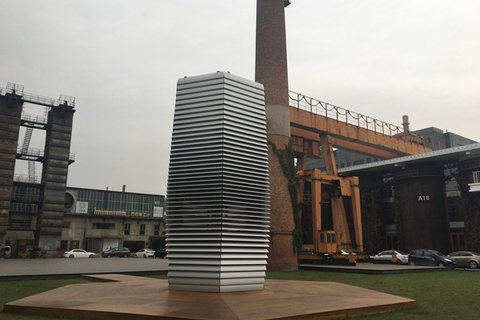Air-Scrubbing Tower Gives Beijingers Breathing Room

(Beijing) — A 7-meter-tall smog-eating purifier displayed at an art park in smoggy Beijing seems an unlikely solution to the sprawling city's chronic air pollution problem.
But the outdoor air purifier has resolved a key issue for joggers who live near the 751 Art Park: It's cleaning enough air to provide breathable space for a morning run.
The filter-equipped "Smog Free Tower," designed by Dutch architect Daan Roosegaarde, has been attracting joggers as a functioning air purifier and exhibit piece ever since it was installed in early October.
Local joggers started adjusting their running routes to include the tower area after hearing that the park's air was cleaner than air in other parts of the neighborhood, a park security guard told Caixin.
The guard's also noticed he's breathing a lot easier.
"I came to work on a Thursday when the air in Beijing was seriously polluted," said the guard, who asked not to be named. "I felt the air was cleaner, clearer to see through."
The electric-powered purifier pulls in dirty air through an opening at the top of the tower and blows out clean air through a bank of slots on the sides. It releases enough purified air to fill a zone the size of a soccer field, according to tests conducted in the Netherlands, said Wang Gang, the product's sales representative at Yingshi Consultancy in Tianjin.
Yingshi worked with Roosegaarde to install the exhibit as an experiment in Beijing, a city of more than 20 million often blanketed in gray haze. The Dutch designer was inspired to develop the tower after visiting Beijing in 2013, according to China Dialogue Weekly, an environmental publication.
Roosegaarde hasn't said how much a tower costs, although a source close to Yingshi said the price tag is about 4 million yuan ($594,000).
At that price, installing enough towers to scrub Beijing's air would probably cost a fortune. "Thousands and even tens of thousands" of units would be needed to make a difference, Wang said.
What the tower display is already accomplishing, Wang said, is that it's raising public awareness of air pollution problems in the capital city and across China.
The key to tackling China's smog problem now lies in the hands of government authorities, said Liu Guozheng, who heads the secretariat at the China Environment Reports Association. He called on authorities to implement stringent measures that reduce emissions and require more advanced industrial processes.
Meanwhile, Liu said, smog-eating towers may be useful in some places on extremely polluted days.
Near Beijing, property developers and government agencies in Hebei province have looked into buying towers, according to Wang. Their interest is tied to growing demand for indoor air purifiers and other anti-smog goods in China.
However, not all clean-air products currently on the market have met government standards.
Purifiers made by 14 of 56 manufacturers and tested in Shanghai failed to meet national standards, the General Administration of Quality Supervision, Inspection and Quarantine announced Friday.
Contact reporter Li Rongde (rongdeli@caixin.com); editor Eric Johnson (ericjohnson@caixin.com)
- MOST POPULAR






